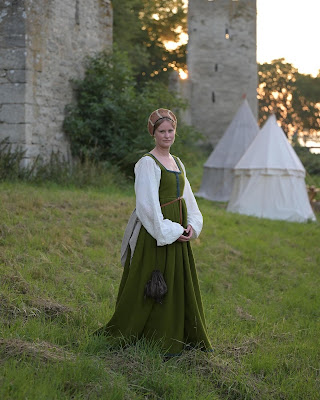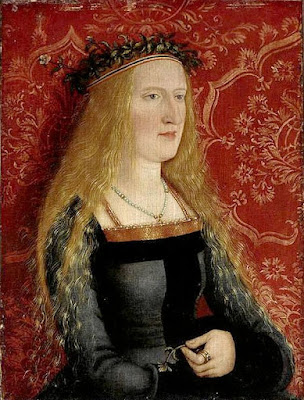In the event of late I got reminded of my interest for the camp women of 16th century Germany again. So many are fascinated by them, and so am I and has been, for a very long time. But it is really important to me to make something as authentic as possible and to always question why I do things a certain way. It is so easy seeing someone doing something and just follow, even though you know nothing about their research. Its common to see people online referring to woodcuts of nobility calling it "bumla" or landsknecht. Again, German 16th century where not a country with a population of only military...doing German 16th century does not mean campwomen or landsknechts only.
Landsknecht and camp women.
Early modern armies traveled with a large number of noncombatants, the number where extremely high in relation to the number of troops. And according to John A Lynn II in Women, Armies and Warfare in early modern Europe most of these people where women and children.
So, who where they?
It was not uncommon for young couples to leave low paying jobs to go with the army, not for the honor to fight for the country but for the money. When I started doing clothing for a 16th century camp woman I got told that they plundered the battlefield after the war. Doing work that was consider female shamed the masculinity of a soldier and therefore such duties were reserved for women, even during campaign.The task of the women was to carry and to plunder. The metaphor of the women being her partners "mule" appears in military commentaries. Charming, right... But the view on the different tasks of men and women were also connected to clothing. When I started doing 16th century clothing I was told that the women plundered the battlefiled and used items like clothing that they took from dying men. And maybe they did take items that could be altered into something else but they did not use a jacket for example, for themselfs, if they found one they could not change they sold it.
The same book mentioned above covers to story of the woodcut The cobbler and his girl, Erhard Schön, 1568. She worked as a spinner to go with him to the war. He left the job as a cobbler. Making shoes might not have been the most profitable job, or just not fun enough? But the information tells us that she was just anybody, a women working with the craft of spinning, unmarried. I really like her clothing. Is she representative for most camp women? I dont know. But she is not wearing the extravagant outfits that we are used to seeing in the world of reenactment today.
She is wearing a rock, gown, with long sleeves. If she is wearing a unterrock, a kirtle, is not possible to determine. Her dress has guards on the bodies but no slits. On top of her gown she is wearing a gollar in form of a little vest with what could be a smocked collar. Gollars in linen with smocked collars can be seen in the woodcuts of dancing farmers and seems to be a garment used for time of partying. I think I have only seen them on dancing farmers, if you find one elsewhere please let me know. I find it interesting that she is wearing such a garment in camp. Was that a way to try to look fancier, like the wife of an officer, or just artistic freedom?
She is also wearing an apron that looks like the kind that covering the entire skirt, a schurz. If you look closely you can see that it has a smock around her waist. Her skirt and the apron is tucked up under the belt like we are used to see on camp women. She has sewn hose, that appear like they could be in different colours, or just the interpretation of seams. I know that striped hose are used among the reenactment people but I have not find any sources saying they where actually striped. It suppose to be to show of that the person wearing them could by a lot of fabric, but I dont really buying it. Prove me wrong...please. She is wearing an oxmule shoe and has a walking stick and a backpack.
On her head she has the typical german stuchlein and a tellerbarett with small feathers around the brim.
I mean, look at this. The lines in the hose. If this would have been in black and white we would have interpreted it as stripes. The women beside him, women in the tross has pale colours, and no slits in their clothing. Even thought they are not that visibly in this exakt part of the painting.
Women of the tross came from simple backgrunds, most of them came from te bauren class, the farmer class. According to the sumptuary laws from the time they could not wear whatever they liked. There is this saying that landsknechts could wear whatever they liked because they had such hard lives. Maximilian I was the one that should have said this. And this is what you always get when trying to say that everybody cant wear brocade. Yes, I know about these words. But I dont think that just because of these everybody, that grew up controlled by the sumptuary laws, after joining the army started to buy whatever they could get hold on, to put what ever money they got, on jewels and brocade. If the soldiers had the money to, their woman could, but far from everybody had. Rich clothing is also indicative of exalted position within the regiment. The flamboyance of dress was a formal insignia of rank. Not everybody had it.The first thing that is stated is that they needed to wear clothing made out of fabrics from the German countries, nothing that was imported. Except for some finer wool for a gollar. But no silk! The only exception is their daughters, they could wear a thin silk hairband. They were not allowed to use embroidered collars, maybe exept from whitework, its not stated. So no smock with different colours than white.
So, what about the plunder? The main plunder did not occur on the battlefield but in the cities close by. It was not uncommon that the armies did not get paid in time or at all. These shortages in pay was a problem because the soldiers were expected to pay for their own food. They also did not stay in barracks but in tent and in civilian homes which could put the civilians in danger of theft and bullying. According to the book The Landsknechts by Douglas Miller the men and woman of the army were often left to find shelter on their own. Shelter in form of a simple tent or a hut made of branches. This was the normality for the bigger part of the army, except for higher ranked officers and their women. There was also the opportunity to seek shelter in a near by city, in the houses of common people of the city. The lives they lived tend to be glorified in the reenactment of today, but life on campaign was not easy.
Just some thoughts from my way of reenactment. Again.




















































